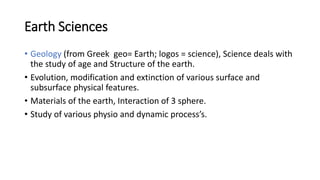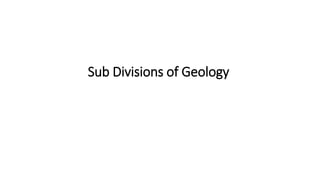Earth sciences
- 1. Earth Science & Geology
- 3. Earth Sciences • Geology (from Greek geo= Earth; logos = science), Science deals with the study of age and Structure of the earth. • Evolution, modification and extinction of various surface and subsurface physical features. • Materials of the earth, Interaction of 3 sphere. • Study of various physio and dynamic process’s.
- 4. Sub Divisions of Geology
- 7. A. Physical Geology • Origin, development and ultimate fate of various surface features and internal features. • Internal agents ( Volcanism and earthquake). • External agents ( Wind, water and ice) on physical features.
- 9. B. Geomorphology • Part of physical geology, study of surface features of earth. • Structure and evolution of these landforms.
- 11. C. Mineralogy • Minerals are basic units. • Deals with formation, occurrence, aggregation and uses of minerals. • Sub- branches and evolution of these landforms.
- 13. D. Petrology • Rock- Natural aggregated form. • Formation, mode of occurrence, composition, textures and structure of different rocks. • Igneous, Sedimentary and metamorphic petrology are branches. • Petrography- Nature and distribution of rocks (geological explanation governing such distribution).
- 15. E. Historical Geology • Past history studied with rocks and features associated with them. • Rocks contain evidence of nature and time of their formation, composition, magnetism, structural disposition and etc. • Fossils (Remains of ancient life). • Paleo geography, palaeontology and stratigraphy are subdivisions.
- 17. F. Economic geology • Study of economic, minerals, rocks and other materials (fuels). • Exploited for Man benefit. • Variety of ores of metals and non-metals, building stones, salt deposits, fuels (Coal, petroleum, natural gas, atomic minerals and industrial materials for refractories, abrasives and insulations and manufacture of chemicals. • Mode of occurrence, principles for formation and accumulation, properties, controls on it and extraction at economic costs.
- 18. Allied Sciences
- 20. A. Geochemistry • Dealing with chemical construction of the earth. • Distribution and relative abundance of different elements. • Trends of reorganization in the elements of earth during geological history through the surface and subsurface process’s.
- 22. B. Geophysics • Methods of physics applied to solve geological problems. • Identification of water and oil bearing strata by geophysical methods. • I.e. Geomagnetism, Geo thermometry, Geo electricity, Geo cosmology and seismology.
- 24. C. Geohydrology • Geological aspects of groundwater and surface water bodies with regards to their occurrence and movements through different rock types.
- 26. D. Mining Geology • Geology applied to mining and quarrying practice. • For the exploration and exploitation of economic minerals deposit.
- 28. E. Engineering Geology • Interaction between the civil engineering and geological sciences. • Geo technical studies of the sites of major projects.
- 30. F. Rock Mechanics • Study of behaviour of rocks under various types of load’s imposed on them (laboratory). • Study of factors geological or responsible for observed and expected behaviour of rocks under different force fields.
- 32. G. Geo Mechanics • Study of natural force fields as acting on the earth on global and regional levels. • Force responsible for the development and disposition of these major features.
- 34. H. Meteorology • Study of atmosphere (physical, chemical and biological aspects). • About weather, study of space through satellite’s.
- 36. I. Oceanography • Study of oceans (physical, structural, genetic and other aspects).
- 37. The End




































